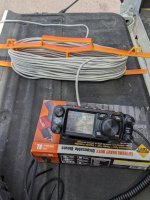KD7RJC
Member
- Joined
- Jun 22, 2023
- Messages
- 107
- Reaction score
- 45
I did an experiment with my Yaesu FTM-500D today that was a success.
The goal was to see how far the control head could be from the radio body, and to also see how tolerant the link is to what in older telephone parlance would be an open bridge tap. The reason for the bridge tap test is to find out if a Y-adapter to one cable to the console-mounted position remaining in place and another cable to a rear-mounted position would work.
This is the sort of Y-adapter that I used, it's a Siemon Y-BRIDGE:

It's an 8P8C Y-adapter with a proprietary plug that would allow it to fit into a socket for a 6P6C jack. For this purpose its compatibility with the 8-pin jack on the radio is what matters. If I keep using this for the long term I might put an industry-standard jack on though so it fits into the socket more securely.
Plugged in:

I first tested with a 20' or so Cat6 ethernet cable, and the signal report I received was positive, no issues at all. So if someone wanted to install one of these FTM-500 radios in an SUV, van, or wagon and to be able to move the control head from the dash or console to the back at the liftgate or hatch they could do so with it permanently wired in to both locations.
After that I wanted to go for length. I took a 100' spool of Cat5 cable that I have and substituted it for the 20':

Even on the reel like this again I had a perfect signal report. I fully expect that if I uncoiled this out to say, operate at a park bench or campsite that it would work no worse than it does being on the coil.
I may also do some testing at home. I'm considering doing the work to install a roof-mounted antenna, nothing too elaborate but I would want to do it right for lightning protection. Since I had cabled my house for Ethernet many years ago, if I can operate the radio cleanly with the body installed at the telecom rack then I could simply patch-in whatever cable goes to the room I want to operate in, meaning that the lightning protection for the station side wouldn't have to be in my office, or the library, or the basement, or wherever else I would choose to sit. Granted this might only work if I keep my "shack" very simple with just the single radio and no advanced CAT control etc so no other devices in the mix.
The goal was to see how far the control head could be from the radio body, and to also see how tolerant the link is to what in older telephone parlance would be an open bridge tap. The reason for the bridge tap test is to find out if a Y-adapter to one cable to the console-mounted position remaining in place and another cable to a rear-mounted position would work.
This is the sort of Y-adapter that I used, it's a Siemon Y-BRIDGE:

It's an 8P8C Y-adapter with a proprietary plug that would allow it to fit into a socket for a 6P6C jack. For this purpose its compatibility with the 8-pin jack on the radio is what matters. If I keep using this for the long term I might put an industry-standard jack on though so it fits into the socket more securely.
Plugged in:

I first tested with a 20' or so Cat6 ethernet cable, and the signal report I received was positive, no issues at all. So if someone wanted to install one of these FTM-500 radios in an SUV, van, or wagon and to be able to move the control head from the dash or console to the back at the liftgate or hatch they could do so with it permanently wired in to both locations.
After that I wanted to go for length. I took a 100' spool of Cat5 cable that I have and substituted it for the 20':

Even on the reel like this again I had a perfect signal report. I fully expect that if I uncoiled this out to say, operate at a park bench or campsite that it would work no worse than it does being on the coil.
I may also do some testing at home. I'm considering doing the work to install a roof-mounted antenna, nothing too elaborate but I would want to do it right for lightning protection. Since I had cabled my house for Ethernet many years ago, if I can operate the radio cleanly with the body installed at the telecom rack then I could simply patch-in whatever cable goes to the room I want to operate in, meaning that the lightning protection for the station side wouldn't have to be in my office, or the library, or the basement, or wherever else I would choose to sit. Granted this might only work if I keep my "shack" very simple with just the single radio and no advanced CAT control etc so no other devices in the mix.

